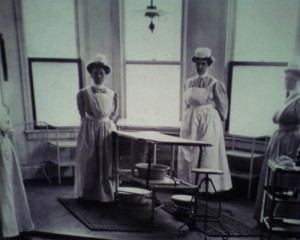Nursing as a profession is older than many people believe.
The deaconess Fabiola played a role in ancient Rome – she established the first Christian hospital in Rome. In fact, in ancient Rome, nurses – almost always female – ran hospitals and did home visits. Midwives existed in the earliest societies. However, the preferred “nurse” remained a member of one’s own family. “Hospital” was used equally as a place for the sick and a place for the destitute. In the Medieval era most hospitals were run by and as part of convents or monasteries. This, of course, ended with the reformation, with the sick ending up in almshouses and municipal hospitals. Most “nurses” were commoner women who had no other way to make a living.
The first formal nursing schools showed up in the mid 19th century, but even then the women received only very basic instruction and the schools were strongly religious in nature. Nursing was still considered a female religious vocation.
Enter Florence Nightingale. A lot of people believe she invented nursing – in fact, she turned it into a profession. She was an educated woman by the standards of the day, properly prepared to be an upper class wife and mother. Instead, she claimed a vocation to serve others and trained, briefly, at a protestant school and hospital in Germany. She became superintendent of a small women’s hospital – and then the Crimean war broke out. Nightingale discovered that British servicemen had no nursing care. She formed a group of nurses and traveled to the Crimea. Even though she didn’t know anything about pathogens, she introduced modern hygiene and laid the foundation for evidence-based practice – creating the modern nursing profession and having a strong influence on medicine in general.

On her return, she was given a trust fund, which she used to establish the first modern School of Nursing at a London hospital, combining classroom education with practical experience.
The Civil War broke out not long after – and America faced all of the same problems. Volunteer nurses with minimal training did most of the care. Some of these women returned home and, using Nightingale’s model, founded nurse training schools of the modern type. Despite opposition from eminent physicians, nurse training schools spread through the country, although many were thinly-veiled ways to get cheap labor for the hospitals they were connected to. Licensing for nurses did not come about until the start of the twentieth century.
Modern nursing education started to coalesce after World War II, with more and more nurses seeking college degrees and the schools seeking independence in control and funding from the hospital. Most nursing education remained diploma based programs or associate degree programs. These associate degree programs, created after World War II, finally opened the nursing profession to men (and also to older and married women). Slowly, the education system moved from hospitals to universities. The role of nurses began to expand, and nurses did tasks previously reserved for doctors. Online university education became popular towards the end of the twentieth century, including in nursing.
The online university courses were used in conjunction with practical training, and form an important part of modern nurse education. An online university cannot substitute for all aspects of nurse training but, like the associate degrees, opens nursing to more prospective students.
Contributing Author: Joe Whyte
Thank you for your sharing. I am worried that I lack creative ideas. It is your article that makes me full of hope. Thank you. But, I have a question, can you help me?